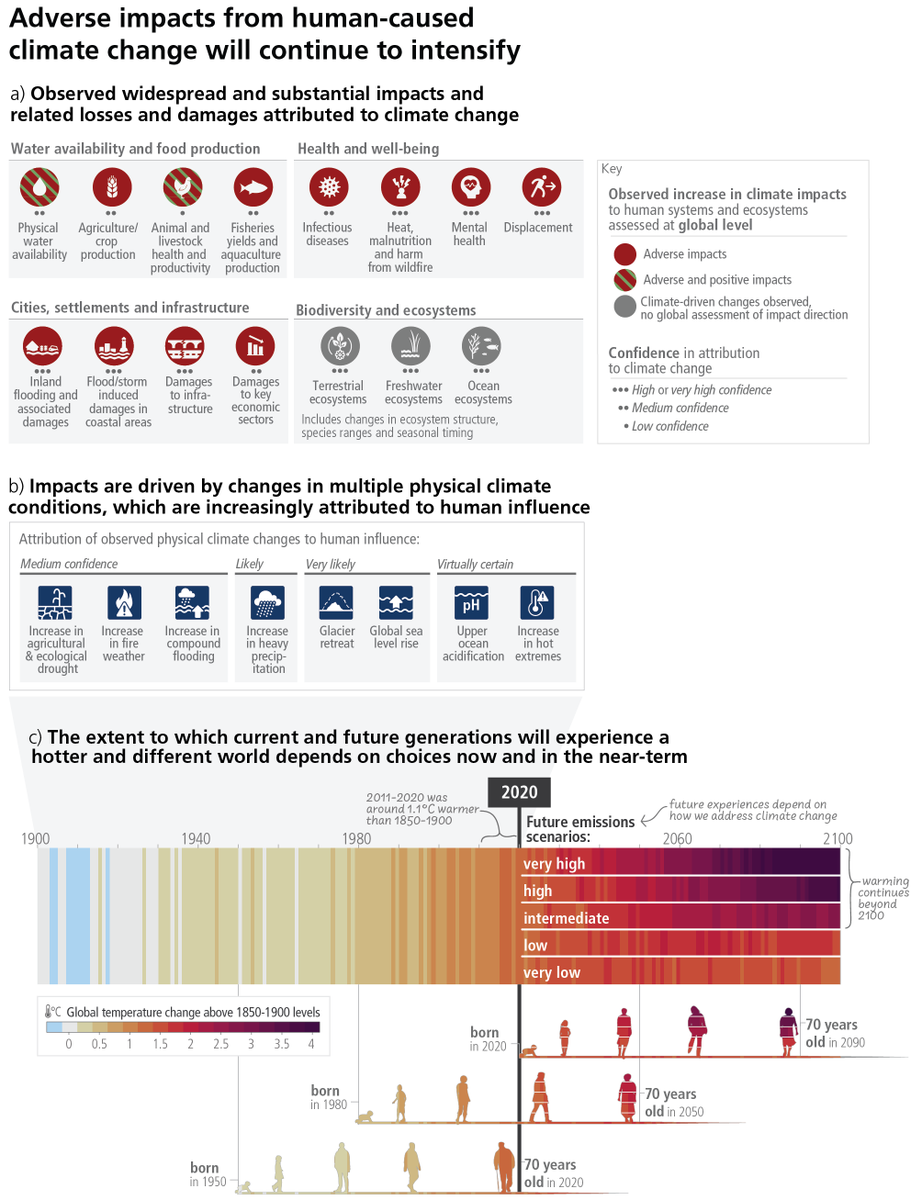As promised, now more on the topics I was deeply involved in as #IPCC #AR6 Synthesis Report author, both in the Summary for Policymakers & the so-called 'Longer Report':
overhoot, net zero, mitigation pathways (incl. CDR)
1/n
overhoot, net zero, mitigation pathways (incl. CDR)
https://twitter.com/Oliver_Geden/status/1637801348514062337
1/n
Let's start with "Overshoot" (B.7), where I was responsible for drafting and 'negotiating' in plenary, but of course not alone (mainly together with @chrisd_jones, with whom I worked on corresponding section 3.3.4 in underlying report)
#IPCC #AR6 #SYR
ipcc.ch/report/ar6/syr/
2/n
#IPCC #AR6 #SYR
ipcc.ch/report/ar6/syr/
2/n

To understand the Overshoot SPM section B.7, we need to start with B.1 on "Future Climate Change", led by @JuneYiLee1 & @sorensson_anna
#IPCC #AR6 #SYR
ipcc.ch/report/ar6/syr/
3/n
#IPCC #AR6 #SYR
ipcc.ch/report/ar6/syr/
3/n

The main overshoot-relevant message here: 1.5C probably reached (& then exceeded) in 2030s, even in the most ambitious WG I and WG III scenarios!
#IPCC #AR6 #SYR
ipcc.ch/report/ar6/syr/
4/n
#IPCC #AR6 #SYR
ipcc.ch/report/ar6/syr/
4/n

Scenarios aren't predictions when exactly 1.5C will be reached (& usually exceeded). Estimates given in footnote, pointing to first half of 2030s.
Important: any warming level is about multi-year averages, not individual years. We're likely to see single 1.5C years by 2030
5/n
Important: any warming level is about multi-year averages, not individual years. We're likely to see single 1.5C years by 2030
5/n

Summaries for Policymakers of WG I (2021) and WG III (2022) reports already included these 2030s timeframes for 1.5C threshold reaching/crossing. Yet, message did not really stick, neither in media nor in broader #climate (policy) community.
Seems to change now
#IPCC #SYR
6/n
Seems to change now
#IPCC #SYR
6/n

This message on 1.5C threshold reaching/crossing in the 2030s comes out even a bit clearer in the longer #SYR version (3.1.1), also referring to the overshoot subsection (3.3.4)
ipcc.ch/report/ar6/syr/
#IPCC #AR6
6/n
ipcc.ch/report/ar6/syr/
#IPCC #AR6
6/n

On 'overshoot', the crucial aspect to understand: in the #IPCC, 'overshoot' doesn't mean just crossing a threshold (like 1.5C), it means exceeding AND then returning to a specified level of warming (like 1.5C)
ipcc.ch/report/ar6/syr/
#IPCC #AR6
7/n
ipcc.ch/report/ar6/syr/
#IPCC #AR6
7/n

Returning to 1.5C could be made possible by net-negative CO2 emissions (not necessarily net-negative GHG), but this won't be an easy way out. Additional deployment of CO2 removal - already substantial for net-zero - would be needed, risks higher, some impacts irreversible
8/n
8/n

A message often overlooked: #IPCC #AR6 has only few 1.5C pathways left without any overshoot, not surprising given rapidly depleting carbon budget.
Some adverse impacts could make return more challenging, but partly already included in carbon budget & pathway calculations
9/n
Some adverse impacts could make return more challenging, but partly already included in carbon budget & pathway calculations
9/n

Some details on (some of) these 'no overshoot' scenarios here, by @Peters_Glen
Depending on the way the temperature trajectory is calculated, the number of 'no overshoot' scenarios in #IPCC '1.5C with no or limited OS' category C1 is 6-9 (out of 97)
9a/n
Depending on the way the temperature trajectory is calculated, the number of 'no overshoot' scenarios in #IPCC '1.5C with no or limited OS' category C1 is 6-9 (out of 97)
https://twitter.com/Peters_Glen/status/1513435139036041223
9a/n
Message on risks & adverse impacts clear: the higher the magnitude & the longer the duration of overshoot period, the riskier
Comparing impacts during (& following from) overshoot to those from staying at a certain level (e.g. 1.6C) to become a major area of future research
10/n
Comparing impacts during (& following from) overshoot to those from staying at a certain level (e.g. 1.6C) to become a major area of future research
10/n

Also pretty straightforward: the larger the overshoot, the more net-negative CO2 needed to return, which in turn means that the faster the transition to net-zero CO2 and the deeper the non-CO2 cuts the better, specifically if looking at need for CDR
ipcc.ch/report/ar6/syr/
11/n
ipcc.ch/report/ar6/syr/
11/n

Longer #SYR version gives cumulative volumes of net-negative CO2 needed to reduce global temperature by 0.1C (best estimate: 220 Gt). Number is the same for pathway category C1 ('1.5C with no to limited OS'), and 360 for 'high OS' (C2)
Net-negative CO2 < gross CO2 removal
12/n
Net-negative CO2 < gross CO2 removal
12/n

Unfortunately, #IPCC #AR6 WG3 (and therefore #SYR) scenarios don't report gross CDR from land use & forestry, hence no detailed comparison of gross CDR in 'no' vs. 'limited' vs. 'high' overshoot pathways can be given
See my thread on CDR in IPCC WG3
12a/n
See my thread on CDR in IPCC WG3
https://twitter.com/Oliver_Geden/status/1511395251621138443
12a/n
• • •
Missing some Tweet in this thread? You can try to
force a refresh

 Read on Twitter
Read on Twitter














